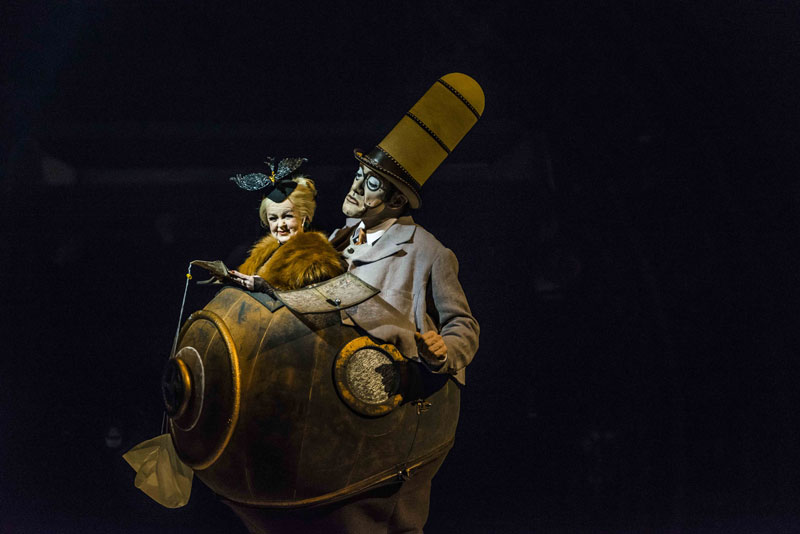Over the decades Montreal’s Cirque du Soleil has been a frequent visitor to San Francisco, pitching its blue and yellow big top next to AT&T Park with one lavishly designed and abstrusely titled touring show after another. Now celebrating its 30th anniversary, the company is back in town with the US premiere of its 35th original production, Kurios—Cabinet of Curiosities.
If last year’s Amaluna evoked The Tempest and 2011’s Totem had a vague “We Are the World” theme, Kurios will be remembered as “the steampunk one.” It’s set in a fanciful Victorian world of weird science, with a set by Stéphane Roy full of immense, bubble-topped machinery. White-jacketed scientists and insectoid robots with faces like African masks wander around looking busy. The music, by Raphaël Beau and the duo of Bob & Bill, adds a taste of 1930s Parisian jazz to the company’s usual lush soundscape, with bewitching nonsense vocals by singer Eirini Tornesaki, wearing a Victrola horn on her hat.

Kurios is written and directed by Michel Laprise, a longtime special effects designer with the company, helming a Cirque show for the first time. And indeed, this production is all about the visuals. There are plenty of strikingly surreal characters roaming around in Philippe Guillotel’s delightfully outlandish, Bauhaus-inspired costumes. Karl L’Ecuyer’s Mr. Microcosmos has a round metal body like a Bathysphere, which doubles as an apartment for an elegantly dressed little person (one-meter-tall Antanina Satsura). There’s a man whose body is made of accordion bellows (Nicolas Baixas) and a woman (Ekaterina Pirogovskaya) with a skirt made of hoops unencumbered by fabric. Occasionally we see a befuddled-looking scientist (Anton Valen) with pointy hair like Alfala from Little Rascals.

These intriguing oddballs don’t really do much but mill around and watch the acts. If you read the character descriptions, you’ll find that the scientist is actually the central figure, called the Seeker, and that the others are the strange denizens of Curiosistan, come to inspire his imagination. Mr. Microcosmos is the embodiment of technological progress, and the woman who lives in his belly is his intuitive, unconscious mind, babbling in a high-pitched voice. (As with most Cirque shows, on the rare occasions when people speak they usually do so in gibberish.) The woman with the hoop skirt is intended to symbolize the dawn of telecommunications. None of this can really be gleaned by watching the show, but it scarcely matters because it all looks great.
Of course we don’t really go to the circus for the story, but to be dazzled by feats of skill and daring, and Kurios delivers on both fronts. Even if there isn’t any one showstopper act, there’s a wide variety of spectacles to gawk at, from juggling and yo-yo spinning to aerial acts: Roman Tereshchenko functions as a human trapeze, flinging wife Olena Tereshchenko into the air; Anne Weissbecker climbs all over a bicycle as it swings high above the ground; and brothers Roman and Vitali Tomanov soar across the stage on straps as conjoined twins. A spectacular troupe of acrobats bounds to what feels like the top of the big top using a net as a trampoline.

Throughout, the impact is accentuated by the marvelous visual design. Four women in eel costumes do a beautifully synchronized contortion act on top of an immense robot hand. Entering as an aviator in a fantastical flying machine, James Eulises Gonzalez Correa does a terrific rola bola act—balancing on boards stacked atop rolling cylinders—on a platform that rises perilously high. An already impressive chair-balancing act by Andrii Bondarenko becomes spellbinding when we see that it’s mirrored by a parallel scene taking place upside-down far over our heads.


